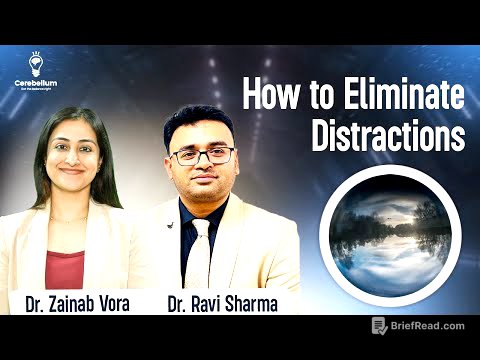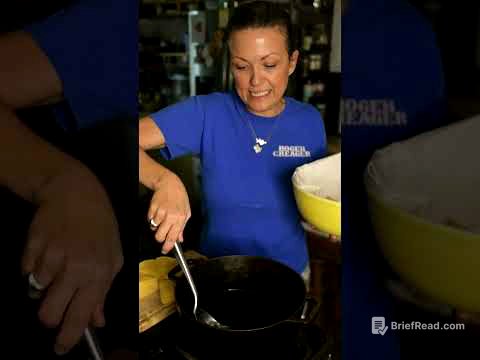TLDR;
This video explains specific rotation in the context of optical activity and how it relates to the rotation of plane-polarized light by chiral substances. It covers the experimental setup for measuring optical rotation, the factors that influence it (length of the solution and concentration), and the formula for calculating specific rotation. The video also defines specific rotation and mentions the instrument used for its measurement, the polarimeter, which will be discussed in more detail in the next video.
- Explains specific rotation in the context of optical activity.
- Covers the experimental setup for measuring optical rotation.
- Mentions the instrument used for its measurement, the polarimeter.
Introduction [0:00]
The video introduces the channel as a resource for understanding graduation-level physics topics with explanations tailored for exam preparation. The current topic is specific rotation, building upon previous discussions of optical rotation, optical activity, and related concepts within the unit on calorimetry. The speaker emphasizes the importance of understanding optical rotation before diving into specific rotation.
Optical Rotation Experimental Setup [1:35]
The video reviews the experimental setup used to measure optical rotation. It starts with a source of ordinary light, which is then passed through a slit to create a narrow beam. This ordinary light, which vibrates in all possible directions, is then passed through a polarizer, specifically a Nicol prism made of calcite crystal. The Nicol prism, due to its double refracting properties, splits the light into two rays: an extraordinary ray (E-ray) and an ordinary ray (O-ray). The O-ray undergoes total internal reflection within the prism and is eliminated, while the E-ray, which vibrates in a single plane, passes through, resulting in plane-polarized light. This light is then analyzed using another Nicol prism called an analyzer. Initially, the analyzer is set perpendicular to the polarizer, blocking all light and resulting in darkness. A scale is used to measure the angle of rotation.
Effect of Sugar Solution on Plane-Polarized Light [5:07]
The video explains what happens when plane-polarized light passes through a sugar solution. The plane of polarization rotates by a certain angle. Substances that rotate the plane of polarization are called optically active substances. If the rotation is to the right (clockwise), the substance is called dextrorotatory; if it's to the left (counterclockwise), it's levorotatory. The analyzer must be rotated to re-establish darkness, and the angle of this rotation corresponds to the angle by which the sugar solution rotated the plane of polarization. Each substance has a unique ability to rotate the plane of polarization, which is referred to as its optical activity. Specific rotation is a way to quantify this ability.
Factors Affecting Angle of Rotation [8:50]
The angle of rotation depends on two factors: the length of the solution through which the light passes and the concentration of the solution. A longer tube or a higher concentration of the optically active substance will result in a greater angle of rotation. Concentration refers to the amount of solute (e.g., sugar) in the solvent (e.g., water). The angle of rotation is directly proportional to both the length and the concentration of the solution.
Specific Rotation Formula [10:08]
The video derives the formula for specific rotation. Starting with the observation that the angle of rotation (θ) is proportional to both the length (l) and the concentration (c) of the solution (θ ∝ l * c), a proportionality constant is introduced to create an equation: θ = [α] * l * c, where [α] is the specific rotation. Therefore, the specific rotation can be calculated as [α] = θ / (l * c). The specific rotation depends on the material.
Definition of Specific Rotation [12:17]
The video defines specific rotation by setting the length of the tube to 1 decimeter and the concentration to 1 gram per cubic centimeter. With these values, the specific rotation becomes equal to the observed angle of rotation. Therefore, specific rotation is defined as the angle of rotation observed when plane-polarized light passes through a solution with a concentration of 1 gram per cubic centimeter and a path length of 1 decimeter. An alternative formula is also presented, incorporating mass and volume.
Polarimeter and Next Steps [15:41]
The video mentions that the instrument used to measure specific rotation is called a polarimeter. The working principle of the polarimeter will be explained in the next video. The speaker emphasizes the importance of understanding specific rotation and the polarimeter for grasping related concepts like the Laws of Optical Rotation and the working of the polarimeter.


![[Lớp 11] Buổi 11. Năng lượng con lắc lò xo](https://wm-img.halpindev.com/p-briefread_c-10_b-10/urlb/aHR0cDovL2ltZy55b3V0dWJlLmNvbS92aS9adTRKYXBGTXpBZy9ocWRlZmF1bHQuanBn.jpg)
![How Doctor Who's Missing Episodes Came Back [Part 2]](https://wm-img.halpindev.com/p-briefread_c-10_b-10/urlb/aHR0cDovL2ltZy55b3V0dWJlLmNvbS92aS9LTldtRkpDMTFEcy9ocWRlZmF1bHQuanBn.jpg)





